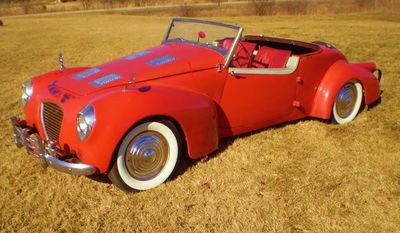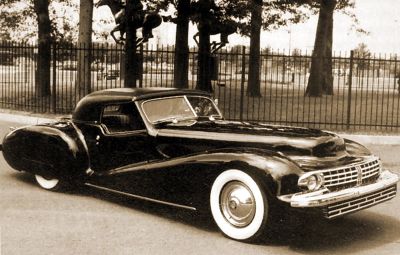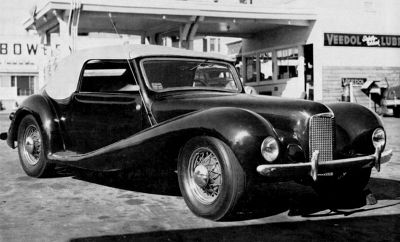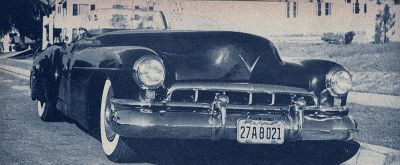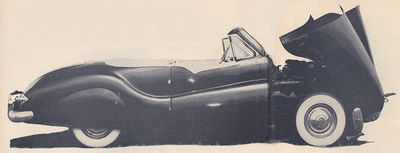Sport Custom Cars



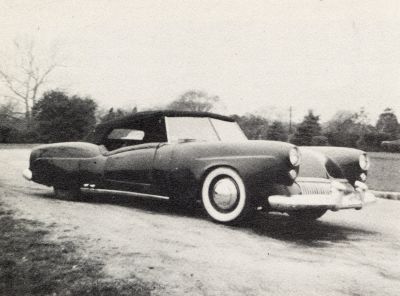
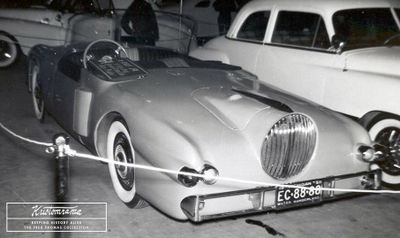



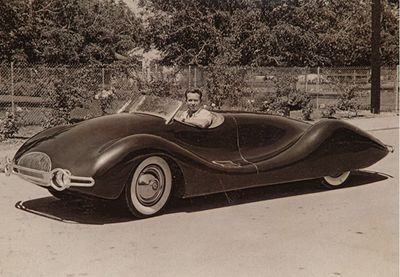



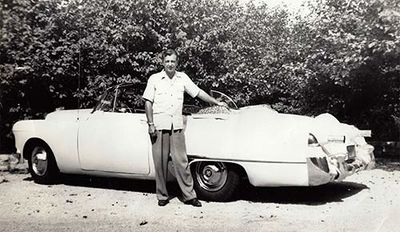








Contents
How They Came to Be
According to Dan Post's Original Blue Book of Custom restyling from 1944, Southern California, the capital of the motion picture industry, was the natural nursery of the sport-custom car. "Though coachmakers all over the country have been kept busy since the industry's infancy with orders for one-of-a-kind limousine bodies, enclosures for touring cars, and an occasional customizing treatment on a roadster, or the once-nippy "speedster," not until the middle thirties did the custom sports car come into its own in the form it is known today." While movie scripts like "The Young in Heart" and "Topper" called for custom cars, many of the starts themselves ordered specialty styled models.[1]
Topper
In 1936 Maurice Schwartz, a partner in the firm of Bohman & Schwartz, constructed the "Topper" movie car for Hal Roach on a Buick chassis. Maurice followed a design by Anthony Garrity of Hollywood. According to Dan Post, the Topper Car gave youth to the infant custom-sport industry.[1]
Charles Martz and Sports Car Craze
A couple of years after the end of World War II, the sports car craze hit America. Buying a British sports car like the Jaguar XK-120 cost a lot of money, so many enthusiasts decided to build their own sports cars. Many homebuilt Sport Customs featured mechanical components from the likes of middle-aged Fords and Hudsons. Charles Martz of Aurora, Montana is often credited for starting the Sport Custom movement nationally. Charles built a sport custom that was featured on the cover of Motor Trend January 1952. Martz created his buttercup-yellow Sport Custom by combining a 1940 Hudson sedan and an ambulance with $700 and seven months of labor. Martz published the result in a book titled Build Your Own Custom Sports Car.
Sport Customs reached the height of their limited popularity in the mid-1950s. Most of the cars were given life by cutting down American coupes and sedans. A Sport Custom was usually bigger than imported sports cars. They were also more powerful, but they often lacked quick handling and driveability.
Sport Customs probably influenced Detroit show cars like the 1951 GM LeSabre. And ironically, the LeSabre certainly influenced Sport Customs. The LeSabre was one of the most copied of Detroit idea cars, as many backyard customs used its theme in the early 1950s.
Three basic designs and methods of construction were used in building Sport Customs. The first approached began with an existing passenger car, usually, a coupe or sedan, cut down to make a 2 - or 4-seater Sportster. Others were built up piece by piece from an assembled, assorted collection of body and chassis components. The third approach involved developing a full custom body built from scratch using metal or fiberglass bodywork.
The Sport Custom Registry
In 1976 the Sport Custom Registry was founded by Tim Hutchins of Burlington, Iowa. The idea behind the club was to promote the preservation of Sport Customs and to provide a clearinghouse for information.
Sport Customs
Henry Rootlieb's 1933 Ford Roadster
Robert E. Roeder's 1934 Ford - The Roeder Sport Custom
Clarence Schaaf's 1937 Cord Special
C. H. Peterson's 1940 Ford-Willys - The Custom Speedster
Manuel Avila's 1940 Ford
Ted Graziano's 1940 Ford Sport Custom
Charles Martz' 1940 Hudson
Kevin Hertfelder's Sport Custom
Al Fitzpatrick's 1940 Packard - The Fitzpatrick Custom
Dave Facey's 1940 Willys Special
Preston Hopkins' Estrata
George McLaughlin's Roadster
The Skylane Motor Special
Doray Inc.'s 1949 Willys
Ed Rotzell's SCOLF
The 1952 Maverick Sportster
Martin S. Papazian's Cordster
The 1954 Cramer Comet
The Manta Ray
The New York Mystery Sport Custom
Lon Hurley's 1946 Cadillac
The Rotzell 46
Robert McClure's Custom
Brad and Gale Bez' 1948 Buick Roadmaster Roadster
Robert L. Darling's 1949 Buick
William J. Unger's 1949 Cadillac Convertible
Glenn Stauffer's 1949 Chevrolet Convertible
The 1950 Saturn
The Donz Lancer
W. Frantz' Sport Custom
Jack Kirsch's 1954 Cadillac
1956 Volante
Bob Metz' La Rocket
Norman Timbs' Buick Special
Ray Reed's 1941 Chevrolet
Garner Jones' 1951 Ford Sport Custom - The Little Jewel
Bob Knessel's Sports Custom
Sources
Did you enjoy this article?
Kustomrama is an encyclopedia dedicated to preserve, share and protect traditional hot rod and custom car history from all over the world.
- Help us keep history alive. For as little as 2.99 USD a month you can become a monthly supporter. Click here to learn more.
- Subscribe to our free newsletter and receive regular updates and stories from Kustomrama.
- Do you know someone who would enjoy this article? Click here to forward it.
Can you help us make this article better?
Please get in touch with us at mail@kustomrama.com if you have additional information or photos to share about Sport Custom Cars.
This article was made possible by:
SunTec Auto Glass - Auto Glass Services on Vintage and Classic Cars
Finding a replacement windshield, back or side glass can be a difficult task when restoring your vintage or custom classic car. It doesn't have to be though now with auto glass specialist companies like www.suntecautoglass.com. They can source OEM or OEM-equivalent glass for older makes/models; which will ensure a proper fit every time. Check them out for more details!
Do you want to see your company here? Click here for more info about how you can advertise your business on Kustomrama.
